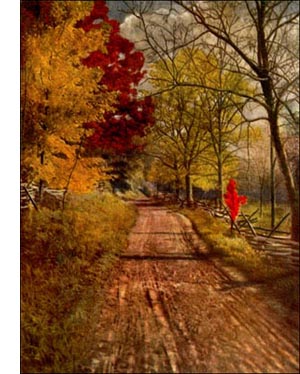Pacific Post Oak or Oregon White Oak Tree
 Pacific Post Oak, Oregon White Oak (Quercus Garryana, Hook.)-Large tree (or a shrub) 60 to 100 feet high, with stout erect or spreading branches forming a compact head. Bark orange brown or greyish, with shallow fissures and broad ridges; twigs rufous, hairy. Wood light yellowish brown, hard, firm, strong, tough. Buds large, pointed, coated with red fuzz. Leaves obovate or oblong, 4 to 6 inches long, coarsely 7 to 9-lobed, with shallow sinuses and blunt lobes, leathery, dark green, shining, with pale or orange-brown hairy lining and conspicuous veins. Flowers: staminate in hairy catkins; pistillate,; sessile, solitary. Acorns annual, 1/2 to 1 inch long, pointed, in shallow, fuzzy cup with small, thin, loose scales. Preferred habitat, dry, gravelly slopes. Distribution, Vancouver Island and the valley of the lower Fraser River, along coast valleys to Santa Cruz Mountains. Best and most abundant in western Oregon and Washington Shrubby on mountains, Uses: The most important timber oak on the west coast. Wood of young trees especially tough and valuable. Used in construction of ships, buildings, vehicles, agricultural implements, barrels and in finer cabinet work; excellent fuel.
Pacific Post Oak, Oregon White Oak (Quercus Garryana, Hook.)-Large tree (or a shrub) 60 to 100 feet high, with stout erect or spreading branches forming a compact head. Bark orange brown or greyish, with shallow fissures and broad ridges; twigs rufous, hairy. Wood light yellowish brown, hard, firm, strong, tough. Buds large, pointed, coated with red fuzz. Leaves obovate or oblong, 4 to 6 inches long, coarsely 7 to 9-lobed, with shallow sinuses and blunt lobes, leathery, dark green, shining, with pale or orange-brown hairy lining and conspicuous veins. Flowers: staminate in hairy catkins; pistillate,; sessile, solitary. Acorns annual, 1/2 to 1 inch long, pointed, in shallow, fuzzy cup with small, thin, loose scales. Preferred habitat, dry, gravelly slopes. Distribution, Vancouver Island and the valley of the lower Fraser River, along coast valleys to Santa Cruz Mountains. Best and most abundant in western Oregon and Washington Shrubby on mountains, Uses: The most important timber oak on the west coast. Wood of young trees especially tough and valuable. Used in construction of ships, buildings, vehicles, agricultural implements, barrels and in finer cabinet work; excellent fuel.This oak has leaves and rusty twigs that bear a striking resemblance to the post oak of our Eastern coast barrens. The bark, however, is pale grey, and often broken into squares by transverse fissures. The acorns are quite distinctive, being large, often over an inch long, nearly twice as long as wide, and set in a small cup, often shallow as that of Quercus rubra.
Upon the mountain slopes this oak is scrubby in growth, but in the rich loam of the lower valley land it is a lofty tree, which often loses its lower limbs by the crowding of young conifers about it. The crown expands, the outer branches become pendulous, and the tree assumes the shape of a tall Etruscan vase -a common form of our American elms.
The whiteness of the wood makes it popular for the interior finish of houses, as well as for the coarser staple uses to which white oak is devoted. Its fault is checking as it dries. It takes two years to season properly.
Robert Douglas, the great botanical explorer, named this tree in honour of Nicholas Garry, secretary of the Hudson Bay Company, in recognition of the courtesies and substantial aid rendered by him to scientists studying the flora of the Northwest.